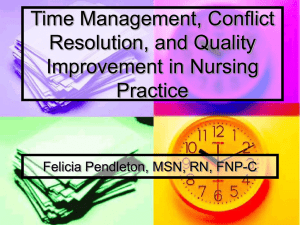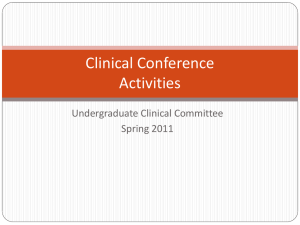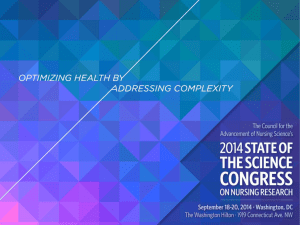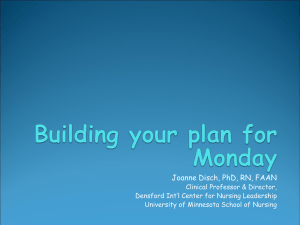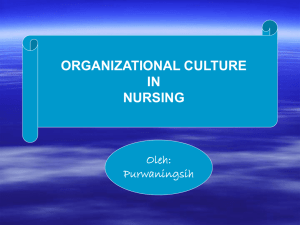Nursing on the Edge of Possibilities - What will It
advertisement
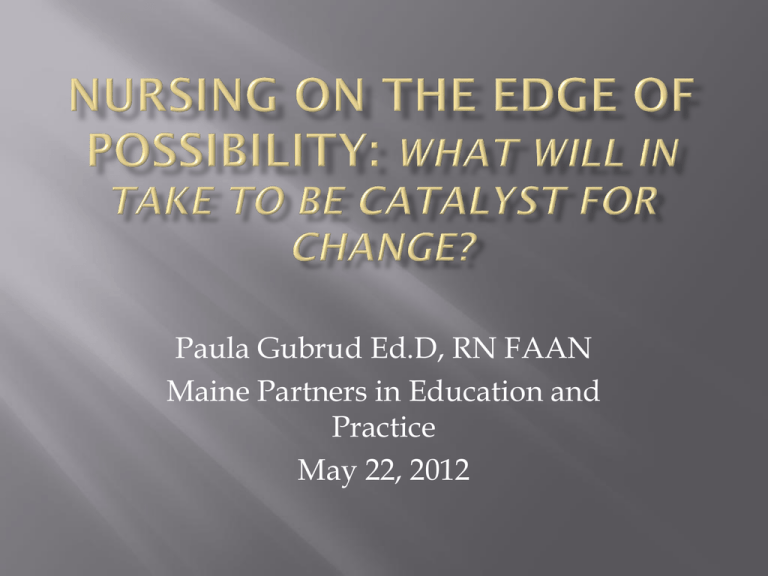
Paula Gubrud Ed.D, RN FAAN Maine Partners in Education and Practice May 22, 2012 Transforming Nursing Practice and Education will require: Acknowledging new realities New Curriculum New Pedagogy for New Learners New Models for Clinical Education New Organizations New Leadership Increasing complexity of population needs Constant rapid change in our organizations Burgeoning use of knowledge and technology required to practice Paradoxical image at the edge of health care reform Essentially static nursing education system Practice/Education Gap Immobilized by disputes about “levels of education” Uninformed by advances in science of learning Clinical education approaches unchanged since the 1940’s Oregon Nurse Leadership Council/Collaborative A conflict in practice created opportunity for collaboration Five Member Organization Oregon Council for Associate Degree Nursing Oregon Council of Deans Oregon Nurses Association Northwest Organization of Nurse Executives Oregon State Board of Nursing 2 Goals related to nursing education Double Enrollment Transform Nursing Education to align with today’s practice environment New Curriculum to Prepare a “New Nurse” with competencies beyond those in our traditional nursing programs with deeper understanding of prevalent health care conditions and situations prepared to function in times of chronic nurse shortage prepared to lead and influence policy A Partnership of Oregon nursing programs designed to: Prepare the “new” nurse with competencies needed for changing health care demographics Increase capacity in nursing programs Increasing number of baccalaureate graduates by creating shared 4 year curriculum Prepare leaders needed to influence new health care systems • Competency-based, directed toward knowledge & abilities needed to provide: • Patient/relationship centered care • For an aging & increasingly diverse population • In highly complex environments • That increasingly require interdisciplinary teamwork, leadership and use of quality improvement, informatics and technology • • • Competencies describe a “new” nurse Preparation of this new nurse will probably take 4 years Requires a new system of nursing education using all available resources from existing educational programs Curriculum – outcomes, selection, organization & sequence of content & learning experiences Pedagogy – assumptions about the learning and approaches that recognize the continued advances in the science of learning and integrates the characteristics of diverse learners Baccalaureate curriculum with opportunity for community college students to complete AAS and sit for NCLEX on the way to BSN Built on redefined fundamentals Competency-based Integrated Spiral Evidence-Based Practice Relationship Centered Care Clinical Judgment Leadership In the context of Health Promotion Ethical practice Intentional (self-directed), reflective learner Engage in teamwork and provide leadership With strong communication skills and capable of systems thinking Skillful clinical judgment and evidencebased practice Courses organized around foci of care: Health Promotion Chronic Illness Management Acute Care End-of-Life Care And “cross-cutting competencies” Leadership & Outcomes Management Population Based Care providing for multiple encounters with most important concepts, dimensions of competencies, & health & illness context in varying populations & settings Draws on tremendous advances in the science of learning from a variety of disciplines (cognitive science, psychology, higher education) Emphasizes deep understanding of the discipline’s most central concepts Guides design of learning activities which promote: Active engagement of the learner Clear performance expectations, practice and frequent, specific and constructive feedback Guides design of learning activities which promote: Strong, learning-focused social interactions Development of habits in metacognition/reflection, self assessment, and selfdirected learning . CORE/Mega Cases that integrate across competencies, relate to highly prevalent health problems, across age span and diverse populations Dilemma cases underscoring ethical issues Unfolding cases, demonstrated clinical situations as they unfold Student narratives of their own experience Purposeful Design of Clinical Education Considering development of Practical knowledge Skilled Know-how Habits of Thought Understanding of self as caring clinician Focused Direct Client Care Integrative Experience Intervention Skill Based Experiences CLINICAL LEARNING Concept Based Case Based Simulation Focused Direct Client Care Intervention Skill Based Experiences Integrative Experience CLINICAL LEARNING Concept Based Case Based Simulation Concept Based Case Based Intervention-Skill Based DirectFocused Care Case Based Focused Direct Patient Care Concept Based Intervention Skill Based Integrative Experience Intervention Skill Based II ConceptBased Case-Based Coordinating Council Faculty committees Stakeholder involvement Agreement for a new kind of leadership Consortium-wide consensus building approach Faculty development & involvement Developing trusting relationships Keeping the vision alive Setting the common good above individual interests Celebration and humor (Buttons) Inclusiveness Facilitation to smooth rough edges & move forward Front story – the statement of vision, tag line “Working together for healthy communities” Back story – commitment to collaborative process and preparing a new kind of nurse for future health care Embrace ambiguity and tolerate false starts – to enjoy the “unfolding” process A “good enough vision” Paradox and Tension Multiple Actions Risk Taking Boundary Spanning Guiding principles for working together Develop and Document (sometimes a facilitator will be needed) Front story – formal document Back story – living to the agreement Commitment to excellence Inclusiveness Beneficence, collegiality Courage/perseverance Healthy conflict, and most importantly- support, embrace and celebrate your commitment to the health of Maine’s Citizens If you want to go quickly, go alone. If you want to go far, go together. Visit us at www.ocne.org Gubrud, P., & Schoessler, M. (2010). OCNE clinical education model. In N. Ard & TM Valiga (Eds) Clinical nursing education: Current reflections (pp. 39-58). New York: National League for Nursing Gubrud-Howe, P., & Schoessler, M. (2008). From random access opportunity to a clinical education curriculum. Journal of Nursing Education, 47(1), 3-4. Gubrud-Howe P. Shaver KS. Tanner CA. Bennett-Stillmaker J. Davidson SB. Flaherty-Robb M. Goudreau K. Hardham L. Hayden C. Hendy S. Omel S. Potempa K. Shores L. Theis S. Wheeler P. (2003) A challenge to meet the future: nursing education in Oregon, 2010. Journal of Nursing Education. 42(4):163-7 Heifetz, R., Grashow, A., & Linsky, M. (2009). The Practice of Adaptive Leadership. Boston MA: Harvard Business Press Lindberg, C., Nash, S. & Lindberg, C. (2008). On the Edge: Nursing in the Age of Complexity. Bordentown, New Jersey: Plexus Press Tanner, C. A. (2010). From mother duck to mother lode: Clinical education for deep learning. Journal of Nursing Education, 49,(1), 3-4. Tanner, C.A., Gubrud-Howe, P., & Shores, L. (2008). The Oregon Consortium for Nursing Education: A Response to the Nursing Shortage. Policy, Politics and Nursing Practice, 9(3):203-09. Zimmerman, B., Lindberg, C., & Plsek. (2008). Edgeware: Lessons from complexity science for health care leaders.



